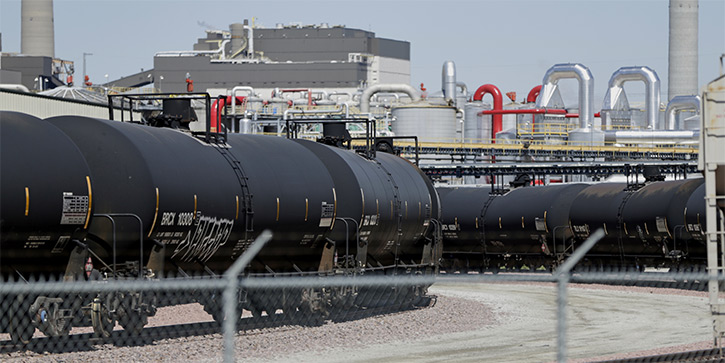
You Could Have Made This +60% Gain from Negative Oil Prices
- Robert Ross
- |
- The Weekly Profit
- |
- April 29, 2020
Last week, the world woke up to something we’d never seen before.
Oil futures had turned… negative?
That’s right. The price of the May 2020 oil futures contract fell as far as -$40 last week.
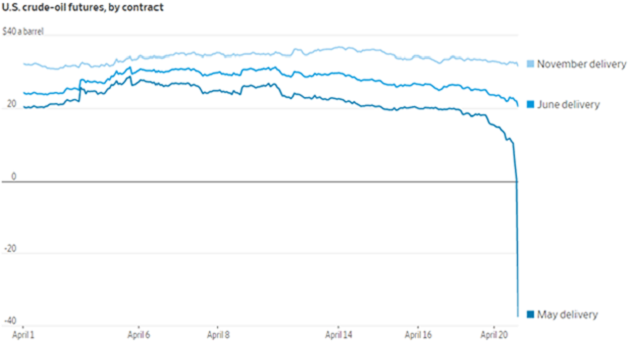
Source: Wall Street Journal
Just to clarify, I’m not saying the oil price fell 40%. I’m saying the price went to -$40.
It took a few minutes to wrap my head around this. But once I did, it became clear how we could profit. Especially since this wasn’t a one-time occurrence… the June 2020 contract dipped below zero this week.
Will oil make a comeback from the abyss, or is the US and Canadian oil industry doomed? Is this a “buy the dip” or a “lose your shirt” scenario? We’ll cover this and more LIVE across five days of presentations and panels at our first-ever live virtual Strategic Investment Conference that happens May 11─21.
See our current speaker and topic list, and claim your spot, here.
Now, let’s review what these negative oil prices mean.
Sorry, But Gas Stations Won’t Pay You to Fill Your Tank
The futures market was built for farmers and other groups that want to lock in today’s commodity prices for future delivery.
Airlines, for example, buy oil contracts that expire on a future date when they expect they will need to “refuel” their supply. In the meantime, they don’t need to find extra warehouse space to store that oil.
Then there are the speculators who don’t want to take possession of the oil, corn, lean hogs, or other commodities they bet on. They just want to make money from their bets on where prices will go, by a certain date.
What happened last week was that the contract for May delivery fell below the zero line. This happened on the day the May contract was expiring.
This meant speculators had to pay for the privilege of NOT having to store 42-gallon drums of black gold… on top of what they paid to enter the trade!
Oil prices finished last Monday at -$37. But that doesn’t mean your gas station will pay YOU $37 per gallon to fill up your tank.
Negative oil prices tell us there’s too much oil and not enough demand for it.
COVID-19 has brought the global economy to a halt. But what didn’t stop was the amount of oil flooding the markets from Saudi Arabia, Russia, and other major oil-producing countries.
And finding enough space to store all this oil was already a challenge. Now, with tankers docked, cars parked, and airports looking like ghost towns, oil traders are paying companies to store their oil.
That system is currently turned upside-down.
And that’s where opportunity lies…
The Smart Way to Profit from Negative Oil Prices
I’ve had many readers reach out asking how to profit from this unusual situation.
Most of the question are, “Which oil stock do I buy to profit?”
Well, if you’ve been reading The Weekly Profit or watching my YouTube channel, you know I’m not bullish on the oil sector.
That’s even with the major oil stocks down 40% in 2020:
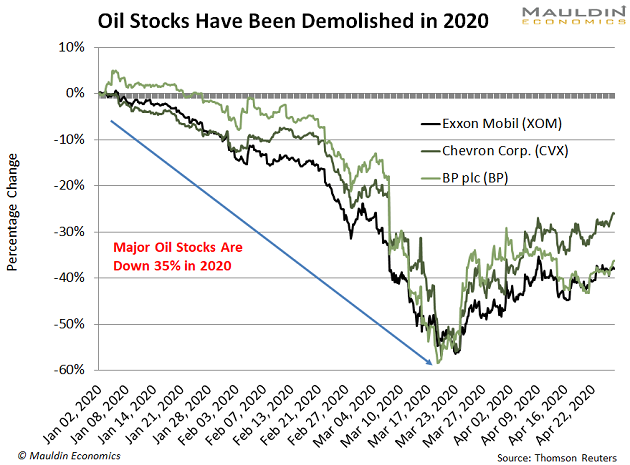
Instead, I prefer to buy companies that benefit from low oil prices.
And this strategy has already started to pay off…
This Industry LOVES Low Oil Prices
For lots of companies like airlines, shippers, and railroads, oil is a major expense.
But you know I’m not very bullish on airlines. Until we have a COVID-19 vaccine, airlines will continue to struggle.
However, there’s one industry that is insulated from COVID-19 issues and benefits from low oil prices.
I’m talking about gold miners.
Gold Miners Have Never Looked Better
Gold miners are in a unique position.
For one, stock market fears are rising. And that’s good news for gold.
Gold is a classic safe haven asset. That means investors buy gold when risks rise.
That’s a major reason gold is up 13% in 2020 while the S&P 500 is down double digits:
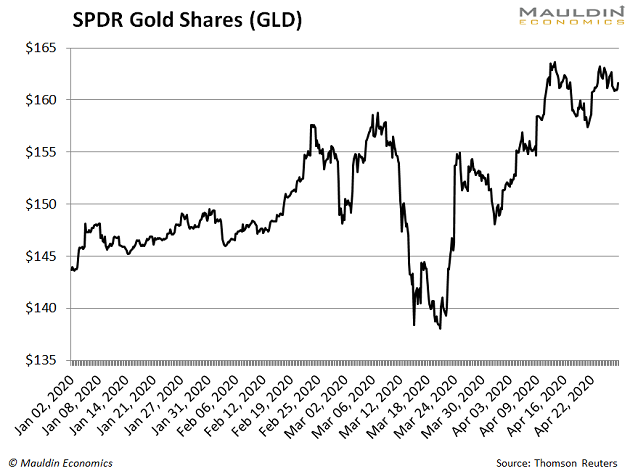
For gold miners, that means the product they’re mining is rising in value.
But miners are getting a boost from the oil collapse as well…
Low Oil Prices Are Music to Gold Miners’ Ears
Gold mining machinery is a sight to behold. For instance, take a look at some of the heavy machinery used in gold mining:

Source: YouTube
As you can imagine, that thing doesn’t run on solar power. No, it takes barrels and barrels of oil to operate it every single day.
That’s why, on average, oil accounts for 20% of gold miner expenses.
So with prices of major miner expenses falling and the asset mined (gold) rising, miners are in a great position.
But if you had subscribed to my premium investing service In the Money, you would have already profited off this.
You Could’ve Had a +60% Gain with This Miner
Back in October, I told my premium subscribers to buy Newmont Corp. (NEM).
The company is the world’s largest gold miner. I had readers buy Newmont in anticipation of falling oil prices and rising demand for gold.
Demand for gold was rising because—at the time—the stock market was near all-time highs.
And since oil accounts for 24% of NEM’s expenses, it would benefit from the deteriorating oil market.
This turned out to be a great idea. Since the initial recommendation, our position is up 62%:
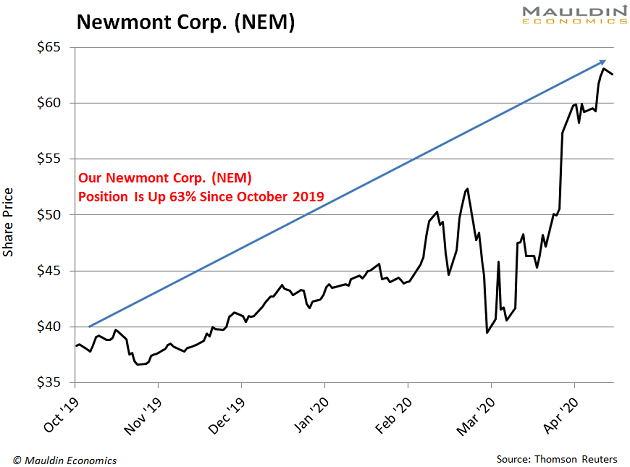
Not bad considering we just fell into the fastest bear market in history.
There Will Soon Be More Opportunities like Newmont
For those who want broad exposure to the gold mining industry, you can buy an Exchange-Traded Fund (ETF) like the VanEck Vectors Gold Miners ETF (GDX).
This ETF holds a basket of different gold miners. This includes Newmont Corp. (NEM), Barrick Gold Corp. (GOLD), and Agnico Eagle Mines (AEM).
And while the ETF is not up 60%, it’s still well in the green in 2020:
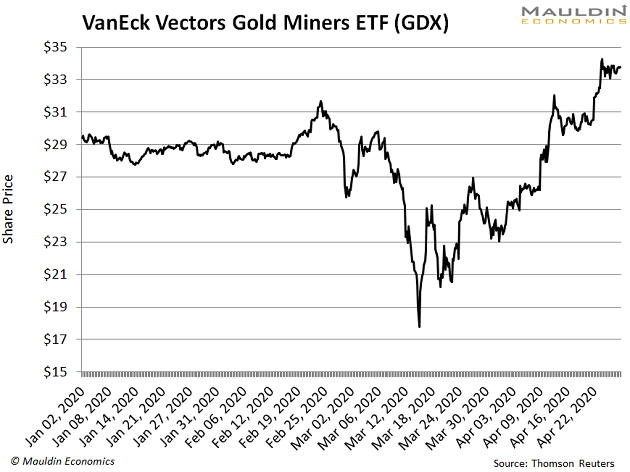
Newmont Corp. (NEM) was a homerun trade for In the Money readers. But I can assure you it won’t be the last.
If you’d like to try In the Money risk-free for 30 days, you can do so here.

Robert Ross

